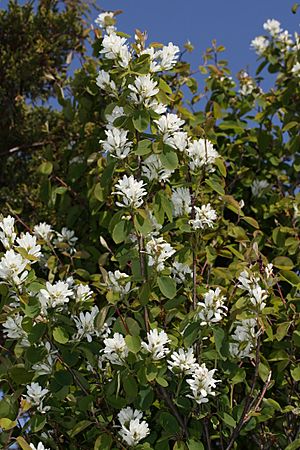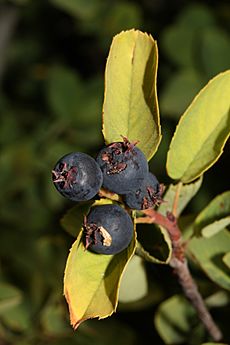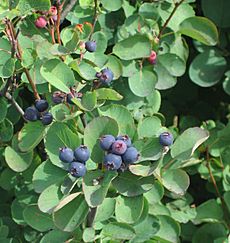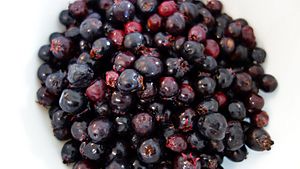Saskatoon berry facts for kids
Quick facts for kids Saskatoon berry |
|
|---|---|
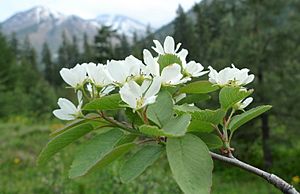 |
|
| A. a. var. semiintegrifolia at Icicle Canyon, Chelan County Washington | |
| Conservation status | |
| Scientific classification | |
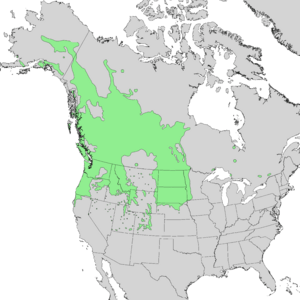 |
|
| Natural range of Amelanchier alnifolia | |
| Synonyms | |
|
The saskatoon berry (scientific name: Amelanchier alnifolia) is a special type of shrub or small tree. It grows tasty, berry-like fruits. You can find it all across western Canada and in the western and central parts of the United States. It also grows in Alaska.
People call it by many names, like Pacific serviceberry, western serviceberry, or western juneberry. Long ago, some people also called it "pigeon berry." This plant grows from sea level up to very high mountains, like 3,400 m (11,200 ft) in the Rocky Mountains. It is a common plant found under taller trees in forests.
Contents
What's in a Name? The Saskatoon Story
The name "saskatoon" comes from the Cree language. The Cree word for these berries is misâskwatômina. The city of Saskatoon, Saskatchewan, is even named after this delicious berry!
The plant's scientific name, alnifolia, is Latin. It combines two words: "alnus," which means "alder" (another type of tree), and "folium," which means "leaf." So, alnifolia means "alder-leaf."
What Does the Saskatoon Berry Plant Look Like?
The saskatoon berry plant is a deciduous shrub or a small tree. This means it loses its leaves in the fall. It usually grows to be about 1–8 m (3–26 ft) tall. Sometimes, it can grow even taller, up to 10 m (33 ft). These plants often grow in groups, forming small colonies.
Leaves, Flowers, and Fruit
The leaves are shaped like ovals or circles. They are about 2–5 cm (3⁄4–2 in) long. The edges of the leaves have small teeth, mostly on the top half. Animals like deer, elk, and rabbits enjoy eating the leaves.
In spring, the plant grows white flowers. Each flower has five separate petals. They are about 2–3 cm (3⁄4–1+1⁄4 in) wide. These flowers grow in small bunches of three to 20 flowers. They appear when the new leaves are just starting to grow.
The fruit is a small, round, purple berry. It is about 5–15 mm (3⁄16–19⁄32 in) across. The berries ripen in early summer near the coast. Further inland, they ripen later in the summer. Many wild animals, including birds, squirrels, and bears, love to eat these berries.
Saskatoon plants are also important for some butterflies. The pale tiger swallowtail, two-tailed swallowtail, and western tiger swallowtail butterflies use the plant as a place for their young to grow.
Growing Saskatoon Berries
Farmers plant saskatoon berry seedlings in rows. They leave about 13–20 feet (4.0–6.1 m) between rows. Each plant is placed 1.5–3 feet (0.46–0.91 m) apart. A single saskatoon bush can produce fruit for 30 years or even longer!
Saskatoon plants can grow in most types of soil. However, they do not like very wet soils or heavy clay soils. They need a lot of sunshine for their fruit to ripen well. These plants are very tough and can handle cold winters. But, late frosts in May can sometimes harm the flowers.
How People Use Saskatoon Berries
Saskatoon berries have a sweet, nutty taste. Indigenous peoples in Canada have eaten them for a very long time. They eat them fresh or dried. A famous food called pemmican uses dried meat and saskatoon berries. The berries add flavor and help keep the meat fresh.
Today, people use saskatoon berries in many ways. They make saskatoon berry pie, jam, and even wines, cider, and beers. You can also find sugar-coated saskatoon berries. These are like dried cranberries and are used in cereals, trail mix, and snack foods.
Saskatoon Berry Nutrients
Saskatoon berries are good for you! They have lots of important nutrients.
| Nutrients in raw saskatoon berries | ||
| Nutrient | Value per 100 g | % Daily Value |
|---|---|---|
| Energy | 85 kcal | |
| Total dietary fiber | 5.9 g | 20% |
| Sugars, total | 11.4 g | 8% |
| Calcium | 42 mg | 4% |
| Magnesium | 24 mg | 6% |
| Iron | 1 mg | 12% |
| Manganese | 1.4 mg | 70% |
| Potassium | 162 mg | 3% |
| Sodium | 0.5 mg | 0% |
| Vitamin C | 3.6 mg | 4% |
| Vitamin A | 11 IU | 1% |
| Vitamin E | 1.1 mg | 7% |
| Folate | 4.6 µg | 1% |
| Riboflavin | 3.5 mg | > 100% |
| Panthothenic acid | 0.3 mg | 6% |
| Pyridoxine | 0.03 mg | 2% |
| Biotin | 20 µg | 67% |
These berries have a lot of dietary fiber, riboflavin, and biotin. They also contain important minerals like iron and manganese. This is similar to the nutrients you find in blueberries.
What are Polyphenols?
Saskatoon berries also contain special plant compounds called polyphenols. These are good for your health. They are similar to the polyphenols found in blueberries. Some important polyphenols in saskatoon berries include quercetin and different types of anthocyanins. Anthocyanins are what give the berries their purple color.
Images for kids
See also
 In Spanish: Guillomo de Saskatchewan para niños
In Spanish: Guillomo de Saskatchewan para niños



